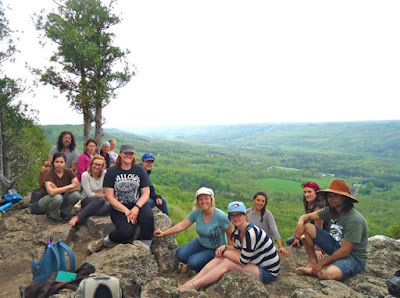Story of the Day for Sunday May 17
After a beautiful Saturday night potluck full of wild foods, and a
beautiful fire, our plants group got up on Sunday morning with a transplanting
mission. In the long grasses under some pine trees, tiny sugar maple seedlings
were trying to grow. Before the mower could reach them, it was our plan to
plant some of these maples elsewhere.
Mixing the native soil with some of the potting soil so that the young
plants would not be shocked, we each took turns digging out two seedlings and
potting them up for our trees and stewardship weekend in June.
 We then got into vehicles, and headed to an established hardwood forest
on the Niagara Escarpment. Moments after being on the trail, there were little
bunches of white flowers and single magenta-pink blossoms lining the way. What
were some of the differences between the various types of native cherry we
wondered? Choke, Pin and Black Cherry. . . and what (if anything) can be done
with their blossoms?
We then got into vehicles, and headed to an established hardwood forest
on the Niagara Escarpment. Moments after being on the trail, there were little
bunches of white flowers and single magenta-pink blossoms lining the way. What
were some of the differences between the various types of native cherry we
wondered? Choke, Pin and Black Cherry. . . and what (if anything) can be done
with their blossoms?
Past honeysuckles, wild strawberries and endless amounts of deer browse,
we climbed. Stopping at a Hop Hornbeam, a member of the Birch family, we found
out that it has edible seeds that hang in a cluster similar to hops. The
maple and ash trees nearby also have edible seeds, which are more palatable
before maturing, as the older, the more bitter they seem to get.
Hiking up the slope, we encountered many, many trilliums, varying in
colour from bright white to dark maroon, some with a distinctive ripe smell
that attracts some of the pollinators (tricked into thinking they will get a
carrion meal). There were also some examples of both false and true Solomon's
seal, which can be differentiated by the way they flower.
Many spectacular orchids were found, including the Yellow Lady Slipper,
whose flower smelled of mango! , and a beautiful patch of pink and white Showy
Orchis. After a lunch atop the mountain, we listened to birds and even saw a
beautiful Rose-Breasted Grosbeak.
Traversing down the slope, on our way to refill our water bottles from a
natural aquifer, we passed the Coffee Plant - a cool find with plenty of
further research about how to get that delectable brew from it!
Visiting the "supermarket" of the lowlands, a name Euell
Gibbons imparted upon Cattail, we tasted some young shoots and discussed
survival uses and foods from all seasons that could be made from this plant.
Even the mucous/slime that lines the inner cattail can be useful as a bit
of natural topical painkiller.
 As we headed back to our starting point, before closing our circle with
porcupine browsed poplar buds, we encountered our final member of the Solomon
Seal family - Star flowered - with some very young and delectably edible
shoots. Our last edible find - a morel! To more adventures next time!
As we headed back to our starting point, before closing our circle with
porcupine browsed poplar buds, we encountered our final member of the Solomon
Seal family - Star flowered - with some very young and delectably edible
shoots. Our last edible find - a morel! To more adventures next time!Written by: Lee Earl - 2nd Year Plants Apprentice





No comments:
Post a Comment